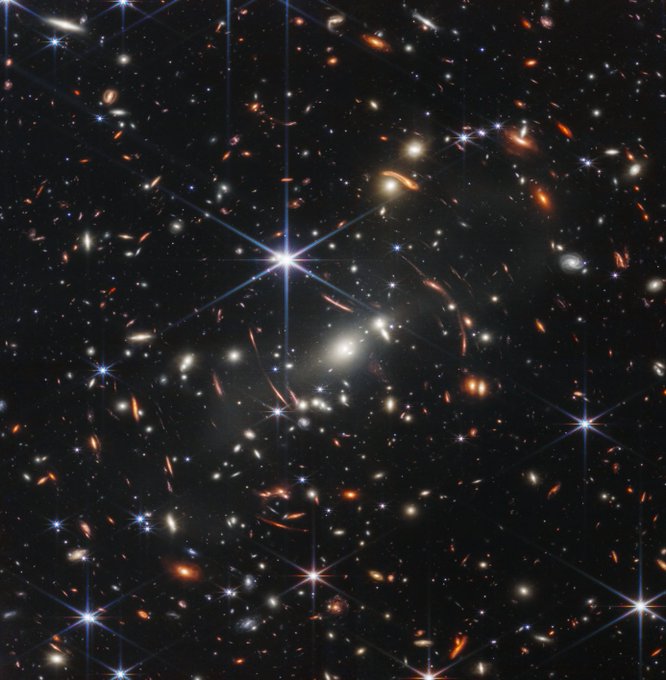It’s a day that’s been highly anticipated in astronomy circles and beyond. Monday we will get the deepest view of the cosmos ever captured, thanks to the extraordinary capabilities of the James Webb Space Telescope (JWST).
The first image from the $10-billion telescope is going to show the farthest humanity has ever seen in both time and distance, closer to the dawn of the universe and the edge of the cosmos.
U.S. President Joe Biden will reveal the first image around 5 p.m. ET, followed by four more galactic beauty shots on Tuesday.
NASA said Biden will show a “deep field” image. That shot is likely to be filled with lots of stars — “lots” being an understatement — with massive galaxies in the foreground distorting the light of the objects behind, telescoping them and making faint and extremely distant galaxies visible. Part of the image will consist of light from not too long after the Big Bang.
The images to be released Tuesday include a view of a giant gaseous planet outside our solar system, two images of a nebula where stars are born and die in spectacular beauty and an update of a classic image of five tightly clustered galaxies that dance around each other.
New space telescope offering a potential view of universe’s origins – Feb 1, 2022
The JWST is the successor to the Hubble Space Telescope, which has not only provided stunning images, but has also been vital in providing scientific knowledge about our universe and its origins.
A high-definition photo of the “Pillars of Creation,” as taken by the Hubble Space Telescope.
NASA, ESA, STScI, and J. Hester and P. Scowen (Arizona State University)/Hubble Heritage Team (STScI/AURA)
The JWST has a much larger primary mirror than Hubble (2.7 times larger in diameter, or about six times larger in area), giving it more light-gathering power and greatly improved sensitivity over the Hubble.
The JWST launched, and there were no second chances — its extremely distant location in the solar system makes it impossible for human crews to work on.
Engineering teams celebrate at the Space Telescope Science Institute in Baltimore as the second primary mirror wing of NASA’s James Webb Space Telescope unfolds, before beginning the process of latching the mirror wing into place, Saturday, Jan. 8, 2022.
Bill Ingalls / NASA via The Associated Press
But the telescope’s massive sunshield, with its 107 restraints holding it in place, was released correctly and everything has gone according to plan.
Trending Stories
Trophy hunter shot dead and left on the side of the road in South Africa
New report details generations of violence in Nova Scotia gunman’s family
So far, we’ve been treated to small glimpses of the JWST’s optical brilliance.
In May, the telescope beamed back a round of test pictures showing off stunning images of a neighbouring satellite galaxy called the Large Magellanic Cloud. When compared with previous images captured by the Spitzer Space Telescope, the results are astonishing.
The sharpness and level of detail captured by the Spitzer Space Telescope (left) and the James Webb Space Telescope (right).
NASA/ESA/CSA/STScI
“It’s not until you actually see the kind of image that it delivers that you really internalize and go ‘wow!’” University of Arizona’s Marcia Rieke, chief scientist for Webb’s near-infrared camera, said at the time. “Just think of what we’re going to learn.”
And in March, the telescope handed in a spectacular star photo to NASA, passing its first assignment with flying colours.
The telescope alignment evaluation image, focusing in on a star called 2MASS J17554042+6551277, blew researchers’ hair back.
Galaxies and stars can be seen behind the star 2MASS J17554042+6551277 in this image captured by the James Webb Space Telescope.
Courtesy / NASA
“We said last fall that we would know that the telescope is working properly when we have an image of a star that looks like a star,” Lee Feinberg, Webb optical telescope element manager at NASA’s Goddard Space Flight Center, told Cosmos magazine at the time.
“The performance is as good if not better than our most optimistic prediction.”
Scientists believe the telescope will be able to peer back in time, possibly to 100 million years after the Big Bang. And not only do scientists think they can look back into galaxies from that time, but they also think they might be able to determine the composition of those galaxies.
In this 2017 photo made available by NASA, technicians lift the mirror assembly of the James Webb Space Telescope using a crane.
Desiree Stover/NASA
Thomas Zurbuchen, NASA’s science mission chief, said that with the new telescope, the cosmos is “giving up secrets that had been there for many, many decades, centuries, millennia.”
“It’s not an image. It’s a new world view that you’re going to see,” he said during a recent media briefing.
Zurbuchen said when he saw the images he got emotional and so did his colleagues.
“It’s really hard to not look at the universe in new light and not just have a moment that is deeply personal.”
NASA is collaborating on Webb with the European and Canadian space agencies.
— With files from The Associated Press
© 2022 Global News, a division of Corus Entertainment Inc.



